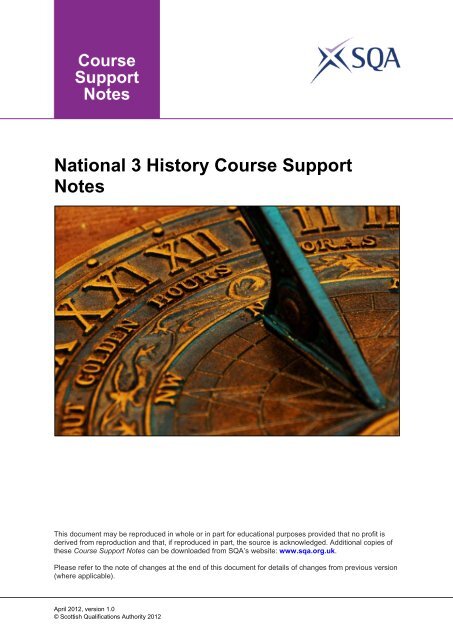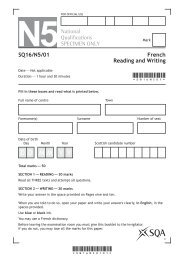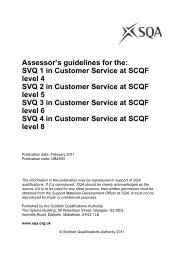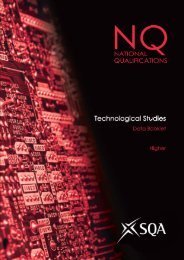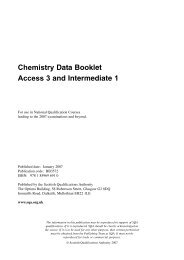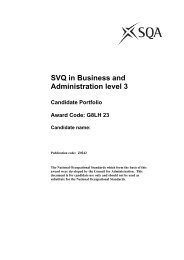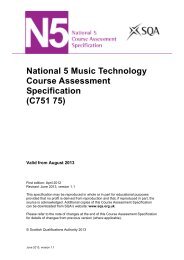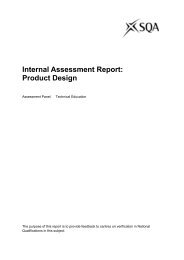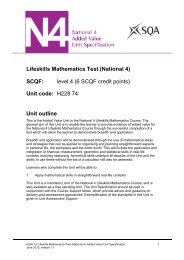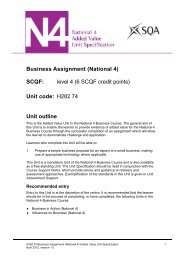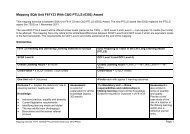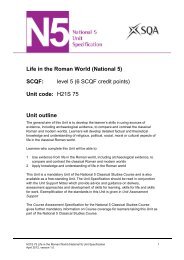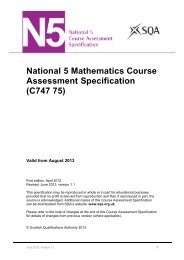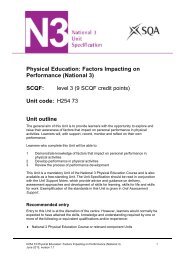National 3 History Course Support Notes - Scottish Qualifications ...
National 3 History Course Support Notes - Scottish Qualifications ...
National 3 History Course Support Notes - Scottish Qualifications ...
Create successful ePaper yourself
Turn your PDF publications into a flip-book with our unique Google optimized e-Paper software.
<strong>National</strong> 3 <strong>History</strong> <strong>Course</strong> <strong>Support</strong><br />
<strong>Notes</strong><br />
This document may be reproduced in whole or in part for educational purposes provided that no profit is<br />
derived from reproduction and that, if reproduced in part, the source is acknowledged. Additional copies of<br />
these <strong>Course</strong> <strong>Support</strong> <strong>Notes</strong> can be downloaded from SQA’s website: www.sqa.org.uk.<br />
Please refer to the note of changes at the end of this document for details of changes from previous version<br />
(where applicable).<br />
April 2012, version 1.0<br />
© <strong>Scottish</strong> <strong>Qualifications</strong> Authority 2012
Contents<br />
<strong>Course</strong> <strong>Support</strong> <strong>Notes</strong><br />
Introduction 1<br />
General guidance on the <strong>Course</strong> 2<br />
Approaches to learning, teaching and assessment 5<br />
Developing skills for learning, skills for life and skills for work 10<br />
Equality and inclusion 12<br />
Appendix 1: Reference documents 13<br />
Unit <strong>Support</strong> <strong>Notes</strong> — Historical Study: <strong>Scottish</strong> (<strong>National</strong> 3) 15<br />
Introduction 16<br />
General guidance on the Unit 17<br />
Approaches to learning, teaching and assessment 18<br />
Equality and inclusion 24<br />
Appendix 1: Reference documents 25<br />
Administrative information 26<br />
Unit <strong>Support</strong> <strong>Notes</strong> — Historical Study: British (<strong>National</strong> 3) 27<br />
Introduction 28<br />
General guidance on the Unit 29<br />
Approaches to learning, teaching and assessment 30<br />
Equality and inclusion 36<br />
Appendix 1: Reference documents 37<br />
Administrative information 38<br />
Unit <strong>Support</strong> <strong>Notes</strong> — Historical Study: European and World (<strong>National</strong> 3) 39<br />
Introduction 41<br />
General guidance on the Unit 42<br />
Approaches to learning, teaching and assessment 43<br />
Equality and inclusion 49
Appendix 1: Reference documents 50<br />
Administrative information 51
Introduction<br />
These support notes are not mandatory. They provide advice and guidance on<br />
approaches to delivering and assessing the <strong>National</strong> 3 <strong>History</strong> <strong>Course</strong>. They are<br />
intended for teachers and lecturers who are delivering the <strong>Course</strong> and its Units.<br />
They should be read in conjunction with the <strong>Course</strong> Specification and the Unit<br />
Specifications for the Units in the <strong>Course</strong>.<br />
<strong>Course</strong> <strong>Support</strong> <strong>Notes</strong> for <strong>National</strong> 3 <strong>History</strong> <strong>Course</strong> 1
General guidance on the <strong>Course</strong><br />
Aims<br />
As stated in the <strong>Course</strong> Specification, the aims of the <strong>Course</strong> are to enable<br />
learners to develop:<br />
a conceptual understanding of the past<br />
a range of skills including the ability to apply a basic historical perspective<br />
and comment on historical sources<br />
a basic knowledge and understanding of the factors contributing to historical<br />
events<br />
a basic knowledge and understanding of the impact of historical events<br />
This <strong>Course</strong> contributes to general education and the wider curriculum. It will help<br />
develop informed and active citizens by helping learners gain a greater<br />
understanding of the past. Learners will develop skills which are transferable to<br />
other areas of study and which they will use in everyday life.<br />
Progression into this <strong>Course</strong><br />
Entry to this <strong>Course</strong> is at the discretion of the centre. However, learners would<br />
normally be expected to have attained some relevant skills and knowledge<br />
through prior experience. Skills and knowledge developed through any of the<br />
following, while not mandatory, are likely to be helpful as a basis for further<br />
learning in this <strong>Course</strong>.<br />
<strong>National</strong> 2 Social Subjects or relevant component Units<br />
Experiences and Outcomes<br />
Learners who have completed relevant Curriculum for Excellence experiences<br />
and Outcomes will find these an appropriate basis for doing the <strong>Course</strong>.<br />
In this <strong>Course</strong> the experiences and Outcomes for Social Studies: People, past<br />
events and societies may provide an appropriate basis for entry to the <strong>Course</strong>.<br />
Learners may also have relevant skills and knowledge gained through other<br />
education systems or from their own interests and informal learning.<br />
Skills, knowledge and understanding covered<br />
in this <strong>Course</strong><br />
This section provides further advice and guidance about skills, knowledge and<br />
understanding that could be included in the <strong>Course</strong>.<br />
The mandatory skills and knowledge will be developed throughout the <strong>Course</strong>.<br />
These are:<br />
<strong>Course</strong> <strong>Support</strong> <strong>Notes</strong> for <strong>National</strong> 3 <strong>History</strong> <strong>Course</strong> 2
commenting on the origin and content of a range of historical sources in a<br />
basic way<br />
commenting on the impact of historical developments and organising basic<br />
information<br />
commenting on the factors contributing towards historical developments, and<br />
drawing basic conclusions<br />
developing a basic factual knowledge and understanding of historical themes<br />
and events in <strong>Scottish</strong>, British, European and World contexts<br />
Progression from this <strong>Course</strong><br />
This <strong>Course</strong> or its components may provide progression to:<br />
<strong>National</strong> 4 <strong>History</strong><br />
other social subjects at <strong>National</strong> 4<br />
Hierarchies<br />
Hierarchy is the term used to describe <strong>Course</strong>s and Units which form a<br />
structured sequence involving two or more SCQF levels.<br />
It is important that any content in a <strong>Course</strong> and/or Unit at one particular SCQF<br />
level is not repeated if a learner progresses to the next level of the hierarchy. The<br />
skills and knowledge should be able to be applied to new content and contexts to<br />
enrich the learning experience. This is for centres to manage.<br />
<strong>History</strong> Units and <strong>Course</strong>s are offered from SCQF level 3 to SCQF level 7.<br />
Vertical progression is possible through the levels of <strong>History</strong> qualifications and<br />
lateral progression is possible to other qualifications in the social studies suite of<br />
<strong>Course</strong>s.<br />
The Units have been written in a hierarchical format, to facilitate multi-level<br />
delivery, allow for learners to achieve at their highest level and allow for<br />
achievement at a lower level, if necessary. This has been accompanied with<br />
considerable flexibility in topics and contexts for learning, to facilitate<br />
personalisation and choice for learners and centres. Through all of the Units of<br />
the <strong>Course</strong> there are options and choices of contexts for learning to allow for new<br />
and stimulating contexts for learning to be built into <strong>Course</strong>s.<br />
The degree of choice and flexibility within the <strong>Course</strong> allows for new areas of<br />
study for learners who progress from one level to another and ensures that<br />
learners are not required to repeat content from one level to the next.<br />
Differentiation can be achieved through the use of more complex sources of<br />
evidence and greater depth of treatment of common issues or topics.<br />
Learning should be progressive, not repetitive, as learners progress through the<br />
levels. While <strong>Course</strong> planning may involve returning to concepts or themes<br />
developed at a lower level in order to develop knowledge and understanding and<br />
skills in greater depth, it is important that any content in a <strong>Course</strong> and/or Unit at<br />
one particular SCQF level is not repeated excessively as a learner progresses to<br />
the next level of the hierarchy.<br />
<strong>Course</strong> <strong>Support</strong> <strong>Notes</strong> for <strong>National</strong> 3 <strong>History</strong> <strong>Course</strong> 3
Example of differentiating content for multi-level delivery<br />
Within the European and World Unit, the topic of Voyages of Discovery could<br />
produce evidence, and learning context, for <strong>National</strong> 3 and <strong>National</strong> 4 candidates<br />
together. <strong>National</strong> 3 candidates could show on a map the routes taken by<br />
explorers such as Columbus. They could give 2 reasons why Columbus set sail<br />
for the Americas.<br />
<strong>National</strong> 4 candidates would also do this, but would provide longer explanations<br />
and could provide more detail of the routes taken, perhaps annotating their map.<br />
Different learners develop at different speeds. Hence, it is important that the<br />
learner is given the possibility to achieve at the highest level. The hierarchical<br />
nature of the Units and <strong>Course</strong> means that individual learners can be assessed,<br />
within the same context, at the appropriate level for them at that time. Learners<br />
should be given the opportunity to be assessed at the highest level they are<br />
capable of. The profile of an individual learner may consist of Units at more than<br />
one level, with some at a level higher than the overall <strong>Course</strong> achieved.<br />
<strong>Course</strong> <strong>Support</strong> <strong>Notes</strong> for <strong>National</strong> 3 <strong>History</strong> <strong>Course</strong> 4
Approaches to learning, teaching<br />
and assessment<br />
<strong>National</strong> 3 <strong>History</strong> has been developed to reflect Curriculum for Excellence<br />
values, purposes and principles. The approach to learning and teaching<br />
developed by individual centres should reflect these principles.<br />
Centres should design <strong>Course</strong>s to encourage active and experiential learning. A<br />
range of teaching and learning approaches should be adopted to meet the<br />
specific needs of individual learners. Individual work, group work and whole class<br />
activities should be used as appropriate. A range of assessment methods should<br />
be used to best reflect the abilities of learners and centres should use<br />
opportunities to collect naturally occurring evidence to demonstrate achievement<br />
of Unit Outcomes.<br />
The <strong>Course</strong> overall is intended to develop all the skills outlined in the <strong>Course</strong><br />
Specification. For assessment purposes these have been allocated to individual<br />
Units. However, the skills should be developed and practiced across all the Units.<br />
Detailed advice and exemplification of approaches to generating evidence<br />
through teaching and learning approaches can be found in the following Unit<br />
<strong>Support</strong> <strong>Notes</strong> for <strong>National</strong> 3 <strong>History</strong>.<br />
Historical Study: <strong>Scottish</strong><br />
Historical Study: British<br />
Historical Study: European and World<br />
The <strong>History</strong> <strong>Course</strong> should be seen as a coherent study of historical<br />
events/themes across <strong>Scottish</strong>, British and European and World contexts. There<br />
will be opportunities throughout the <strong>Course</strong> to reinforce and deepen learning by<br />
making links between aspects of knowledge and understanding across Units,<br />
depending on the particular topics and issues studied.<br />
Each Unit has a specific skills focus for assessment purposes:<br />
Historical Study: <strong>Scottish</strong><br />
Historical Study: British<br />
Historical Study: European and World<br />
Commenting on historical sources<br />
taking into account aspects of their<br />
origin and content<br />
Commenting on the impact of a<br />
historical development, organising<br />
information<br />
Commenting on the factors contributing<br />
towards a historical development,<br />
drawing a basic conclusion<br />
It is important to stress that particular skills have been allocated to individual<br />
Units for assessment purposes only. This is to avoid over-assessment. The skills,<br />
however, are transferable and relevant to all three Units.<br />
<strong>Course</strong> <strong>Support</strong> <strong>Notes</strong> for <strong>National</strong> 3 <strong>History</strong> <strong>Course</strong> 5
These skills, therefore, should be developed across all the Units of the <strong>Course</strong>.<br />
They should not be taught in a narrow way, within one Unit only. The Historical<br />
Studies: <strong>Scottish</strong> Unit will assess the skill of evaluating the content and context of<br />
a range of historical sources and thus will possibly involve a more in-depth<br />
consideration of sources than the other Units. However, this skill can still be<br />
integrated across Units. For example, learners would be encouraged to evaluate<br />
historical sources in British, European and World contexts.<br />
Sequence of delivery<br />
There is no recommended sequence of delivery of the Units. Delivery is at the<br />
discretion of the centre and the models below exemplify possible approaches.<br />
Centres may wish to adopt a sequential approach beginning with more familiar<br />
<strong>Scottish</strong>/British topics and using the knowledge and understanding acquired in<br />
<strong>Scottish</strong>/British contexts to develop knowledge and understanding of international<br />
issues later in the <strong>Course</strong>.<br />
Historical Study:<br />
<strong>Scottish</strong><br />
Historical Study:<br />
British<br />
Historical Study:<br />
European and World<br />
Centres may wish to adopt a thematic approach where a broad topic or theme is<br />
developed across two or more of the Units of the <strong>Course</strong> with knowledge and<br />
understanding developed in the context of one Unit being developed and<br />
deepened through studies in other Units. Such an approach may provide<br />
opportunities for combined assessment. For example, the theme of changes in<br />
society and culture.<br />
Historical Study:<br />
<strong>Scottish</strong><br />
Learners could study the<br />
changes in <strong>Scottish</strong><br />
society and culture in the<br />
1960s<br />
Historical Study:<br />
British<br />
Learners could study the<br />
changes in British society<br />
and culture in the<br />
Victorian era<br />
Learners can be assessed on their knowledge of the reasons for changes in<br />
Victorian Britain, through a source evaluation exercise which would demonstrate<br />
the skills from the <strong>Scottish</strong> Unit. If this approach is used, teachers should ensure<br />
that evidence of content from the <strong>Scottish</strong> Unit is also assessed at an appropriate<br />
stage.<br />
Advice on distribution of time<br />
The distribution of time between the various Units is a matter for professional<br />
judgement and is entirely at the discretion the centre. Each Unit is likely to require<br />
an approximately equal time allocation, although this may depend on the<br />
<strong>Course</strong> <strong>Support</strong> <strong>Notes</strong> for <strong>National</strong> 3 <strong>History</strong> <strong>Course</strong> 6
learners’ prior learning in the different topic areas, teaching and learning methods<br />
adopted and the design of the <strong>Course</strong>.<br />
There is no recommended teaching order for the Units in this <strong>Course</strong>. <strong>Course</strong><br />
planners may wish to consider how best to introduce the <strong>History</strong> assignment; for<br />
example, wait until learners have covered a range of topics before making a<br />
decision about the topic or issue to be studied. However the development of skills<br />
should be a part of teaching and learning from the outset and learners will<br />
progressively build up the skills and retain evidence of these skills throughout the<br />
<strong>Course</strong>.<br />
Assessment and gathering evidence<br />
There are likely to be opportunities in the day-to-day delivery of the Units in a<br />
<strong>Course</strong> to generate evidence which satisfies completely or partially a Unit or<br />
Units. This is naturally occurring evidence and may be recorded as evidence for<br />
the Units or parts of the Units.<br />
Teachers and lecturers may wish to design assessments which prepare learners<br />
for the <strong>Course</strong> assessment, considerable flexibility exists in the method and form<br />
of Unit assessment. For Unit assessment purposes, a variety of methods of<br />
assessment could be used to gather evidence such as extended writing, source<br />
evaluation, learner presentations, case studies, role play, research activities and<br />
creation of various media that will allow learners and teachers to establish their<br />
next steps.<br />
Assessment is an integral part of learning and teaching in Curriculum for<br />
Excellence. The <strong>National</strong> 3 <strong>History</strong> <strong>Course</strong> should encourage and support<br />
independent learning. Learners should have a clear understanding of the<br />
requirements of the <strong>Course</strong>. Learners should be encouraged to set their own<br />
learning objectives, assess the extent of their existing knowledge and be<br />
encouraged to review their own progress.<br />
It is important to stress that particular skills have been allocated to individual<br />
Units for assessment purposes only. This is to avoid over-assessment. The skills,<br />
however, are transferable to all three Units and can be assessed in any section of<br />
the question paper component of the <strong>Course</strong> assessment.<br />
Learners learn best when they: understand clearly what they are trying to learn,<br />
and what is expected of them, are given feedback about the quality of their work,<br />
and what they can do to make it better, are given advice about how to make<br />
improvements and are fully involved in deciding what needs to be done next, and<br />
know who can give them help if they need it. To this end:<br />
Teachers and lecturers should share learning/assessment criteria.<br />
Teachers and lecturers should deliver effective feedback.<br />
Teachers and lecturers should encourage peer and self-assessment.<br />
Teachers and lecturers should question effectively using higher order<br />
questioning when appropriate.<br />
<strong>Course</strong> <strong>Support</strong> <strong>Notes</strong> for <strong>National</strong> 3 <strong>History</strong> <strong>Course</strong> 7
The use of assessment for formative purposes can provide an important role in<br />
raising attainment by:<br />
giving feedback<br />
detailing progress<br />
identifying learner strengths and areas for development<br />
Flexibility in the method of assessment within Unit assessments provides<br />
opportunities for learners to demonstrate attainment in a variety of ways and<br />
reduce barriers to achievement.<br />
Understanding the Assessment Standards and making assessment<br />
judgements<br />
The following exemplification aims to provide advice and guidance to centres<br />
when developing activities which may be used to generate evidence that learners<br />
have achieved the Outcomes and Assessment Standards for the Units. These<br />
activities may be ones which allow the identification of naturally occurring<br />
evidence as part of teaching and learning to determine whether the learner has<br />
achieved the Outcome or more formal occasions when centres use a specific<br />
assessment item.<br />
The exemplification aims to provide greater detail and<br />
complement the terminology used in the Outcomes and<br />
Assessment Standards which are based upon the SCQF.<br />
Centres should note that the Unit Outcomes and<br />
Assessment Standards describe a minimum level of<br />
competence for the achievement of the Unit and that<br />
learners will demonstrate a range of levels of ability within<br />
a particular SCQF level.<br />
Centres should note that flexibility exists in creating<br />
assessment items and that a range of factors need to be<br />
considered in determining the level of demand. For<br />
example, while in general, increasing the number of<br />
sources used in a question may increase the level of<br />
demand upon the learner; increasing the complexity of a<br />
single source will also have the effect of increasing the<br />
level of demand.<br />
Greater complexity within a source may be achieved by<br />
increasing the amount of information, the level of detail,<br />
the method of presentation etc. It should also be noted<br />
that a relatively straightforward source may be capable of a range of responses.<br />
A learner operating at a lower SCQF level may be able to draw broad, general,<br />
relatively simple conclusions from a given source while another learner is capable<br />
of a more sophisticated level of analysis and be able to draw more insightful and<br />
detailed conclusions from the same source thereby demonstrating achievement<br />
of a higher SCQF level.<br />
<strong>Course</strong> <strong>Support</strong> <strong>Notes</strong> for <strong>National</strong> 3 <strong>History</strong> <strong>Course</strong> 8
It is important that when using this guidance that centres refer to the appropriate<br />
Unit Specifications and the Outcomes and Assessment Standards for the Unit.<br />
On making assessment judgements between levels the following guidance aims<br />
to provide high level advice on the characteristics of typical learner responses.<br />
Further advice and guidance will be provided in the Specimen Question paper<br />
and marking instructions (<strong>National</strong> 5 and Higher), Specimen coursework and<br />
marking instructions (<strong>National</strong> 5 and Higher), Added Value Unit assessment<br />
support (<strong>National</strong> 4 only) and Unit Assessment <strong>Support</strong> (all levels).<br />
Level Possible learner responses Possible question<br />
types/command<br />
words<br />
Higher<br />
<strong>National</strong> 5<br />
<strong>National</strong> 4<br />
<strong>National</strong> 3<br />
Extended response<br />
Explanation and analysis required<br />
Clear and structured expression of complex<br />
ideas<br />
Extensive and detailed use of evidence<br />
Able to consider different perspectives on<br />
an issue<br />
Able to make judgements<br />
Detailed response<br />
Description and explanation required with<br />
some analysis<br />
Clarity in expression of ideas<br />
Insightful use of evidence<br />
Use of appropriate exemplification<br />
Limited response<br />
Descriptions and brief explanations<br />
Some clarity and structure in response<br />
Limited use of evidence<br />
Use of obvious exemplification<br />
Short response/outline<br />
Ability to make limited use of simple<br />
evidence<br />
Ability to consider consequences<br />
… Discuss<br />
To what extent …<br />
How far …<br />
Assess …<br />
Critically examine …<br />
Comment on …<br />
Describe, in detail, …<br />
Explain, in detail, …<br />
To what extent …<br />
How important …<br />
Describe …<br />
Give reasons …<br />
Outline …<br />
Comment on …<br />
Learning about Scotland and <strong>Scottish</strong> culture will enrich the learners' learning<br />
experience and help them to develop the skills for learning, life and work they will<br />
need to prepare them for taking their place in a diverse, inclusive and<br />
participative Scotland and beyond. Where there are opportunities to contextualise<br />
approaches to learning and teaching to <strong>Scottish</strong> contexts, teachers and lecturers<br />
should consider this.<br />
<strong>Course</strong> <strong>Support</strong> <strong>Notes</strong> for <strong>National</strong> 3 <strong>History</strong> <strong>Course</strong> 9
Developing skills for learning,<br />
skills for life and skills for work<br />
Through the successful completion of this <strong>Course</strong>, important skills for learning,<br />
skills for life and skills for work are developed. A full list of these is contained in<br />
the <strong>Course</strong> Specification. Further advice on how these skills may be developed is<br />
included in the Unit <strong>Support</strong> <strong>Notes</strong>.<br />
The skills for learning, skills for life and skills for work will not be formally<br />
assessed within the <strong>Course</strong>. However, <strong>Course</strong> planners should identify<br />
opportunities to enhance these skills throughout the <strong>Course</strong>. Learners should be<br />
aware of the skills they are building and teachers/lecturers can provide advice on<br />
opportunities to practice and improve them.<br />
These skills will be developed across all the Units of the <strong>Course</strong>. The Unit<br />
support notes for each Unit will provide further advice on how Units within the<br />
<strong>Course</strong> may provide opportunities to develop particular skills.<br />
There may also be opportunities for other, additional skills for learning, skills for<br />
life and skills for work to be developed in the <strong>Course</strong>. For example, a teaching<br />
approach based on extensive use of group discussions could provide<br />
opportunities to develop the skill of Listening and Talking 1 . However, this could<br />
vary across centres depending on approaches being used to deliver the <strong>Course</strong><br />
in a centre and this is for centres to manage.<br />
1 Further information is provided in the SQA framework of Skills for Learning, Skills for<br />
Life and Skills for Work<br />
<strong>Course</strong> <strong>Support</strong> <strong>Notes</strong> for <strong>National</strong> 3 <strong>History</strong> <strong>Course</strong> 10
Combining assessment across Units<br />
If an integrated or thematic approach to <strong>Course</strong> delivery is used, then there may<br />
be opportunities for combining assessment across Units.<br />
This can:<br />
enrich the assessment process for the learner by linking assessment more<br />
closely to teaching and learning<br />
make more sense to the learner and avoid duplication of assessment<br />
allow for evidence for particular Units to be drawn from a range of activities<br />
allow more time for time for learning<br />
Care should be taken when using combined assessment that those aspects of<br />
the assessment standard not achieved by the combined assessment are covered<br />
by a further assessment. Therefore, when designing an assessment to cover<br />
multiple Units, teachers/lecturers must ensure that they track and record where<br />
evidence of an individual Unit appears.<br />
The following is an example of a written assessment which combines the skills of<br />
the <strong>Scottish</strong> and British Units, but uses only the knowledge and understanding<br />
from the British Unit.<br />
From the Cradle to the Grave? Social Welfare in Britain 1890s-1951<br />
Source B is part of a speech made by Lloyd George in 1908.<br />
Source B<br />
After all, this is a rich country and yet in this rich country you have<br />
hundreds and thousands of people who are unemployed and cannot<br />
afford to feed their families. There are also hundreds of people living<br />
in terrible housing conditions. The Liberal government will help<br />
these people.<br />
1. Give two reasons why Source B is useful as evidence of why the Liberals<br />
introduced social reforms between 1906 and 1914. (Remember to use more<br />
than source content in your answer.)<br />
2. Describe housing conditions for poor people in Britain’s towns in the 19 th<br />
Century.<br />
3. Why did the government introduce the Welfare State in 1945?<br />
<strong>Course</strong> <strong>Support</strong> <strong>Notes</strong> for <strong>National</strong> 3 <strong>History</strong> <strong>Course</strong> 11
Equality and inclusion<br />
The high degree of flexibility within this <strong>Course</strong> in terms possible approaches to<br />
Unit assessment means that <strong>Course</strong> and Unit planners can consider and remove<br />
potential barriers to learning and assessment. Alternative assessment<br />
arrangements and reasonable adjustments can be made to <strong>Course</strong> assessment<br />
requirements in order that this <strong>Course</strong> is accessible to all learners.<br />
It is recognised that centres have their own duties under equality and other<br />
legislation and policy initiatives. The guidance given in these <strong>Course</strong> <strong>Support</strong><br />
<strong>Notes</strong> is designed to sit alongside these duties but is specific to the delivery and<br />
assessment of the <strong>Course</strong>.<br />
It is important that centres are aware of and understand SQA’s assessment<br />
arrangements for disabled learners, and those with additional support needs,<br />
when making requests for adjustments to published assessment arrangements.<br />
Centres will find more guidance on this in the series of publications on<br />
Assessment Arrangements on SQA’s website: www.sqa.org.uk/sqa//14977.html.<br />
<strong>Course</strong> <strong>Support</strong> <strong>Notes</strong> for <strong>National</strong> 3 <strong>History</strong> <strong>Course</strong> 12
Appendix 1: Reference documents<br />
The following reference documents will provide useful information and<br />
background.<br />
Assessment Arrangements (for disabled candidates and/or those with<br />
additional support needs) — various publications are available on SQA’s<br />
website at: www.sqa.org.uk/sqa//14977.html.<br />
Building the Curriculum 3: A framework for learning and teaching<br />
<strong>Course</strong> Specifications<br />
Design Principles for <strong>National</strong> <strong>Course</strong>s<br />
Guide to Assessment (June 2008)<br />
Overview of Qualification Reports<br />
Principles and practice papers for curriculum areas<br />
SCQF Handbook: User Guide (published 2009) and<br />
SCQF level descriptors (to be reviewed during 2011 to 2012):<br />
www.sqa.org.uk/sqa/4595.html<br />
SQA Skills Framework: Skills for Learning, Skills for Life and Skills for Work<br />
Skills for Learning, Skills for Life and Skills for Work: Using the Curriculum<br />
Tool<br />
<strong>Course</strong> <strong>Support</strong> <strong>Notes</strong> for <strong>National</strong> 3 <strong>History</strong> <strong>Course</strong> 13
Administrative information<br />
Published: April 2012 (version 1.0)<br />
Superclass:<br />
to be advised<br />
<strong>History</strong> of changes to <strong>Course</strong> <strong>Support</strong> <strong>Notes</strong><br />
<strong>Course</strong><br />
details<br />
Version Description of change Authorised<br />
by<br />
Date<br />
© <strong>Scottish</strong> <strong>Qualifications</strong> Authority 2012<br />
This document may be reproduced in whole or in part for educational purposes<br />
provided that no profit is derived from reproduction and that, if reproduced in part,<br />
the source is acknowledged. Additional copies can be downloaded from SQA’s<br />
website at www.sqa.org.uk.<br />
Note: You are advised to check SQA’s website (www.sqa.org.uk) to ensure you<br />
are using the most up-to-date version.<br />
<strong>Course</strong> <strong>Support</strong> <strong>Notes</strong> for <strong>National</strong> 3 <strong>History</strong> <strong>Course</strong> 14
Unit <strong>Support</strong> <strong>Notes</strong> — Historical Study:<br />
<strong>Scottish</strong> (<strong>National</strong> 3)<br />
This document may be reproduced in whole or in part for educational purposes provided that no profit is<br />
derived from reproduction and that, if reproduced in part, the source is acknowledged. Additional copies of<br />
these Unit <strong>Support</strong> <strong>Notes</strong> can be downloaded from SQA’s website: www.sqa.org.uk.<br />
Please refer to the note of changes at the end of this document for details of changes from previous version<br />
(where applicable).
Introduction<br />
These support notes are not mandatory. They provide advice and guidance on<br />
approaches to delivering and assessing the Historical Study: <strong>Scottish</strong> (<strong>National</strong> 3)<br />
Unit. They are intended for teachers and lecturers who are delivering this Unit.<br />
They should be read in conjunction with:<br />
the Unit Specification<br />
the <strong>Course</strong> Specification<br />
the <strong>Course</strong> Assessment Specification<br />
the <strong>Course</strong> <strong>Support</strong> <strong>Notes</strong><br />
appropriate assessment support materials<br />
Unit <strong>Support</strong> <strong>Notes</strong> for Historical Study: <strong>Scottish</strong> (<strong>National</strong> 3) Unit 16
General guidance on the Unit<br />
Aims<br />
The general aim of this Unit is to develop the learner’s skills in using historical<br />
sources. Learners will apply knowledge and understanding of historical events<br />
and themes. Through this study, learners will gain a basic knowledge and<br />
understanding of historical events or themes.<br />
Learners who complete this Unit will be able to:<br />
comment on historical sources<br />
draw on and apply knowledge and understanding of <strong>Scottish</strong> historical events<br />
and themes<br />
Progression into this Unit<br />
Entry to this Unit is always at the discretion of the centre. However, learners<br />
would normally be expected to have attained the skills, knowledge and<br />
understanding required by one or more of the following or equivalent<br />
qualifications and/or experience:<br />
Social Subjects (<strong>National</strong> 2) or relevant component Units<br />
When considering whether this Unit is appropriate for a particular learner, you<br />
should refer to the skills knowledge and understanding for the <strong>Course</strong>, and the<br />
Outcomes and Assessment Standards. Taken together these provide an overall<br />
picture of the level of demand.<br />
Skills, knowledge and understanding covered<br />
in this Unit<br />
Information about skills, knowledge and understanding is given in the <strong>National</strong> 3<br />
<strong>History</strong> <strong>Course</strong> Specification and <strong>Course</strong> <strong>Support</strong> <strong>Notes</strong>.<br />
If this Unit is being delivered on a free-standing basis, teachers/lecturers and<br />
lecturers are free to select the content and contexts for learning which are most<br />
appropriate for delivery in their centres. The content or contexts chosen must fulfil<br />
the mandatory skills, knowledge and understanding as described in the <strong>Course</strong><br />
Specification, and must enable learners to meet the requirements of the<br />
Outcomes and Assessment Standards.<br />
Progression from this Unit<br />
This Unit may provide progression to:<br />
<strong>National</strong> 4 <strong>History</strong><br />
other social subjects at <strong>National</strong> 4<br />
Unit <strong>Support</strong> <strong>Notes</strong> for Historical Study: <strong>Scottish</strong> (<strong>National</strong> 3) Unit 17
Approaches to learning, teaching<br />
and assessment<br />
The aim of this section is to provide advice and guidance to centres on:<br />
opportunities to generate naturally occurring evidence through a range of<br />
teaching and learning approaches<br />
the extent of evidence to retain for quality assurance purposes combining<br />
assessment within Units<br />
approaches to developing skills for learning, skills for life and skills for work<br />
General guidance on the Unit<br />
Deep and effective learning about history involves the study of different aspects,<br />
including describing the events or developments, explaining why these events or<br />
developments came about and the impact they had on Scotland and her people.<br />
There is no prescribed content in <strong>National</strong> 3 <strong>History</strong>. The following examples are<br />
illustrative of approaches which may be adopted and which will allow<br />
opportunities to gather evidence that learners have achieved one or more of the<br />
Unit Outcomes.<br />
Potential approaches to learning and teaching<br />
Below are two examples of possible approaches to learning and teaching for this<br />
Unit, focussing on a topic and considering activities that will help learners develop<br />
their knowledge, understanding and skills.<br />
Each of these examples represents a holistic approach to learning teaching and<br />
assessment that can generate a range of evidence covering all the Assessment<br />
Standards of the Unit. They are adaptable, flexible approaches that can be used<br />
across a range of concepts and contexts in whole, or in part. Elements of these<br />
may be used independently to gather evidence of achieving an aspect of the<br />
overall Outcome of the Unit, or the Outcome in full.<br />
These examples focus on learning, teaching and assessment focussed on the<br />
<strong>Scottish</strong> Unit. However, deep, broad and challenging learning and teaching<br />
across all the Units of the <strong>Course</strong> will develop the skills of learners in an effective<br />
way. These examples could be easily adapted to incorporate elements of both<br />
the British and the European and World Units.<br />
Example 1 – The Impact of the Great War on Scotland<br />
Learners could visit a local war memorial and record the names of those who fell<br />
during the Great War. Learners could then research these names using internet<br />
sites such as the <strong>Scottish</strong> <strong>National</strong> War Memorial and Commonwealth War<br />
Graves Commission Databases.<br />
This will enable them to find out more about local soldiers. Learners could then<br />
produce a document or web page using ICT to present their findings. This will<br />
enable an examination of the impact of significant world event on the local<br />
Unit <strong>Support</strong> <strong>Notes</strong> for Historical Study: <strong>Scottish</strong> (<strong>National</strong> 3) Unit 18
community and develop Learners’ transferable research skills. Learners will also<br />
be able to comment on usefulness of sources such as memorials or web pages<br />
for historical research.<br />
A basic knowledge and understanding of the impact of war on communities will<br />
be developed. There are many opportunities to gather a range of assessment<br />
evidence such as photos, field notes/sketches of visits to local memorials, screen<br />
shots of internet research, as well as the final booklet/web page/document<br />
produced by the learner.<br />
Example 2 – Mary, Queen of Scots<br />
Learners could work on a group activity on the murder of Lord Darnley. Each<br />
group could examine the evidence regarding a different suspect. Using primary<br />
and secondary sources, the group could decide why their person is a suspect<br />
before comparing evidence with that of other groups to reach a decision as a<br />
class. This will allow learners to examine basic sources and make comparisons<br />
between evidence before reaching a final conclusion.<br />
This will develop communication and interpersonal skills as well as provide a<br />
basic understanding of events. There are also opportunities to develop<br />
presentation skills. There is a wealth of material on, for example, BBC Scotland<br />
Education and Learning Teaching Scotland websites which can be adapted for<br />
<strong>National</strong> 3 learners by centres.<br />
Through these approaches learners will have opportunities to generate evidence<br />
which can be gathered and retained by teachers and lecturers to demonstrate<br />
achievement of both Outcomes of this Unit, either wholly or in part.<br />
Unit <strong>Support</strong> <strong>Notes</strong> for Historical Study: <strong>Scottish</strong> (<strong>National</strong> 3) Unit 19
Outcome 1: Comment on historical sources<br />
Outcome 2: basic knowledge and understanding of an area of <strong>Scottish</strong><br />
history<br />
1. Describe the ways in which <strong>Scottish</strong> women campaigned to get the right to<br />
vote before 1914.<br />
2. Give three reasons why the Jacobites lost at the Battle of Culloden.<br />
3. Give three reasons why Scotland’s population grew between 1830 and 1900.<br />
The overall burden of assessment for the learner may be reduced by using the<br />
opportunity to combine assessment within the Unit.<br />
Where centres are using a holistic approach to assessment of the Unit it is<br />
advisable to track where evidence of the achievement of individual Outcomes<br />
appears so that learners who do not achieve the complete assessment can still<br />
Unit <strong>Support</strong> <strong>Notes</strong> for Historical Study: <strong>Scottish</strong> (<strong>National</strong> 3) Unit 20
have recognition for the Outcome(s) they have achieved and do not have to be<br />
reassessed on all of the Outcomes.<br />
Understanding the Assessment Standards and making assessment<br />
judgements<br />
The following information aims to provide advice and guidance to centres when<br />
developing activities which may be used to generate evidence that learners have<br />
achieved the Outcomes and Assessment Standards for the Units. These<br />
activities may be ones which allow the identification of naturally occurring<br />
evidence as part of teaching and learning to determine whether the learner has<br />
achieved the Outcome or more formal occasions when centres use a specific<br />
assessment item.<br />
The explanations given aim to provide greater detail and complement the<br />
terminology used in the Outcomes and Assessment Standards which are based<br />
upon the (SCQF). Centres should note that the Outcomes and Assessment<br />
Standards describe a minimum level of competence for the achievement of the<br />
Unit and that learners will demonstrate a range of levels of ability within a<br />
particular SCQF level.<br />
Centres should note that flexibility exists in creating assessment items and that a<br />
range of factors need to be considered in determining the level of demand. For<br />
example, while in general, increasing the number of sources used in a question<br />
may increase the level of demand upon the learner; increasing the complexity of<br />
a single source will also have the effect of increasing the level of demand.<br />
The following terms are used within the Unit Specification for this Unit:<br />
Outlining involves a learner communicating their understanding of the main<br />
points of, for example, a religious belief. The learner need not provide detail<br />
beyond factual or immediate aspects of the belief (ie pointing out the fact that<br />
many followers of a particular religion hold it) and they need not define the<br />
underlying theoretical or abstract ideas<br />
Providing a basic comment will involve a learner being able to<br />
communicate a point of view in relation to the significance of a religious belief,<br />
practice or source to people’s lives. The comment need not be an original<br />
one, nor need it be the learner’s personal view. A comment may be brief, and<br />
not include a justification for the viewpoint. In contrast to analysis, or<br />
evaluation, the learner need not provide evidence that they have considered<br />
other viewpoints, or challenges to the view they are expressing<br />
Basic terms refers to the amount and quality of information a learner is<br />
expected to provide. At this level, basic terms will involve the learner<br />
demonstrating knowledge of the factual aspects of a source, belief or<br />
practice. They may not show understanding of the interconnectedness of the<br />
topic with other issues, and they may not show understanding of the<br />
complexities or subtleties within an idea, source etc.<br />
Unit <strong>Support</strong> <strong>Notes</strong> for Historical Study: <strong>Scottish</strong> (<strong>National</strong> 3) Unit 21
Holistic assessment<br />
The overall burden of assessment for the learner may be reduced by using the<br />
opportunity to assess holistically within the Unit, allowing achievement of all<br />
Assessment Standards at once. Evidence can be gathered in a range of forms,<br />
as described above.<br />
If centres are using a holistic approach to assessment of the Unit it is advisable to<br />
track where evidence of the achievement of individual Assessment Standards<br />
appears so that learners who do not achieve the complete assessment can still<br />
have recognition for what they have achieved and do not have to be reassessed<br />
on what they have achieved.<br />
It may be helpful to build a record of evidence for each learner. This could be<br />
kept electronically/online and could contain scanned copies of any written work<br />
(including annotated notes, summaries etc); teacher records of observations,<br />
learner interviews, question and answer sessions; videos of discussions, group<br />
work, presentations and debates (it may be appropriate to keep only a sample of<br />
video evidence to back up the teacher record); learning log; records of visits,<br />
interviews, experiences; pictures of posters and/or displays; any other evidence<br />
generated by the learner.<br />
Developing skills for learning, skills for life<br />
and skills for work<br />
Information about developing skills for learning, skills for life and skills for work<br />
across the <strong>Course</strong>, is given in the relevant <strong>Course</strong> <strong>Support</strong> <strong>Notes</strong>. This Unit will<br />
provide many opportunities to develop skills for learning, skills for life and skills<br />
for work.<br />
Through the successful completion of this Unit, important skills for learning, life<br />
and work are developed. These skills include researching, understanding and<br />
using a range of sources; explaining information; and communicating, by a<br />
variety of means, conclusions based on evidence.<br />
The Unit lends itself to the development of literacy skills, particularly reading and<br />
writing. For example, learners may read a variety of texts about historical<br />
events/themes they are studying, including primary as well as secondary<br />
sources. This means that they will also be able to consider many different types<br />
of source and consider their benefits and limitations. Learners should be<br />
encouraged to read as widely as possible and undertake extended writing where<br />
appropriate in order to facilitate progression to the <strong>National</strong> 5 <strong>History</strong> <strong>Course</strong> and<br />
the world of work.<br />
Citizenship will be developed through an examination of Scotland’s place within<br />
the UK and the wider world, self-awareness and growing identity.<br />
Thinking skills will be developed across all <strong>Scottish</strong> time periods. Through the<br />
nature of historical study, learners will develop their understanding of key issues<br />
Unit <strong>Support</strong> <strong>Notes</strong> for Historical Study: <strong>Scottish</strong> (<strong>National</strong> 3) Unit 22
and key events as well as identifiable skills and they will be able to apply them.<br />
The learner will work with a variety of sources of varying difficulties that will<br />
develop their ability to understand knowledge and apply this knowledge.<br />
Learning about <strong>Scottish</strong> history and <strong>Scottish</strong> culture will enrich the learners'<br />
learning experience and help them to develop the skills for learning, life and work<br />
which will help to prepare them for taking their place in a diverse, inclusive and<br />
participative Scotland and beyond.<br />
Unit <strong>Support</strong> <strong>Notes</strong> for Historical Study: <strong>Scottish</strong> (<strong>National</strong> 3) Unit 23
Equality and inclusion<br />
The high degree of flexibility within this Unit in terms possible approaches to<br />
assessment means that <strong>Course</strong> and Unit planners can consider and remove<br />
potential barriers to learning and assessment. This Unit should be accessible to<br />
all learners.<br />
It is recognised that centres have their own duties under equality and other<br />
legislation and policy initiatives. The guidance given in this document is designed<br />
to sit alongside these duties but is specific to the delivery and assessment of the<br />
Unit.<br />
Alternative approaches to Unit assessment to take account of the specific needs<br />
of learners can be used. However, the centre must be satisfied that the integrity<br />
of the assessment is maintained and where the alternative approach to<br />
assessment will, in fact, generate the necessary evidence of achievement.<br />
Unit <strong>Support</strong> <strong>Notes</strong> for Historical Study: <strong>Scottish</strong> (<strong>National</strong> 3) Unit 24
Appendix 1: Reference documents<br />
The following reference documents will provide useful information and<br />
background.<br />
Assessment Arrangements (for disabled candidates and/or those with<br />
additional support needs) — various publications on SQA’s website:<br />
http://www.sqa.org.uk/sqa/14976.html<br />
Building the Curriculum 4: Skills for learning, skills for life and skills for work<br />
Building the Curriculum 5: A framework for assessment<br />
<strong>Course</strong> Specifications<br />
Design Principles for <strong>National</strong> <strong>Course</strong>s<br />
Guide to Assessment (June 2008)<br />
Overview of Qualification Reports<br />
Overview of Qualification Reports<br />
Principles and practice papers for curriculum areas<br />
Research Report 4 — Less is More: Good Practice in Reducing Assessment<br />
Time<br />
<strong>Course</strong>work Authenticity — a Guide for Teachers and Lecturers<br />
SCQF Handbook: User Guide (published 2009) and<br />
SCQF level descriptors (to be reviewed during 2011 to 2012):<br />
www.sqa.org.uk/sqa/4595.html<br />
SQA Skills Framework: Skills for Learning, Skills for Life and Skills for Work<br />
Skills for Learning, Skills for Life and Skills for Work: Using the Curriculum<br />
Tool<br />
SQA Guidelines on e-assessment for Schools<br />
SQA Guidelines on Online Assessment for Further Education<br />
SQA e-assessment web page: www.sqa.org.uk/sqa/5606.html<br />
Unit <strong>Support</strong> <strong>Notes</strong> for Historical Study: <strong>Scottish</strong> (<strong>National</strong> 3) Unit 25
Administrative information<br />
Published: April 2012 (version 1.0)<br />
Superclass:<br />
to be advised<br />
<strong>History</strong> of changes to Unit <strong>Support</strong> <strong>Notes</strong><br />
Unit<br />
details<br />
Version Description of change Authorised<br />
by<br />
Date<br />
© <strong>Scottish</strong> <strong>Qualifications</strong> Authority 2012<br />
This document may be reproduced in whole or in part for educational purposes<br />
provided that no profit is derived from reproduction and that, if reproduced in part,<br />
the source is acknowledged. Additional copies can be downloaded from SQA’s<br />
website at www.sqa.org.uk.<br />
Note: You are advised to check SQA’s website (www.sqa.org.uk) to ensure you<br />
are using the most up-to-date version<br />
Unit <strong>Support</strong> <strong>Notes</strong> for Historical Study: <strong>Scottish</strong> (<strong>National</strong> 3) Unit 26
Unit <strong>Support</strong> <strong>Notes</strong> — Historical Study:<br />
British (<strong>National</strong> 3)<br />
This document may be reproduced in whole or in part for educational purposes provided that no profit is<br />
derived from reproduction and that, if reproduced in part, the source is acknowledged. Additional copies of<br />
these Unit <strong>Support</strong> <strong>Notes</strong> can be downloaded from SQA’s website: www.sqa.org.uk.<br />
Please refer to the note of changes at the end of this document for details of changes from previous version<br />
(where applicable).
Introduction<br />
These support notes are not mandatory. They provide advice and guidance on<br />
approaches to delivering and assessing the Historical Study: British (<strong>National</strong> 3)<br />
Unit. They are intended for teachers and lecturers who are delivering this Unit.<br />
They should be read in conjunction with:<br />
the Unit Specification<br />
the <strong>Course</strong> Specification<br />
the <strong>Course</strong> Assessment Specification<br />
the <strong>Course</strong> <strong>Support</strong> <strong>Notes</strong><br />
appropriate assessment support materials<br />
Unit <strong>Support</strong> <strong>Notes</strong> for Historical Study: British (<strong>National</strong> 3) Unit 28
General guidance on the Unit<br />
Aims<br />
The general aim of this Unit is to develop the learner’s skills in commenting on<br />
the impact of a historical development. Learners will apply knowledge and<br />
understanding of historical events or themes.<br />
Learners who complete this Unit will be able to:<br />
comment on the impact of historical developments<br />
draw on and apply knowledge and understanding of British historical events<br />
and themes<br />
Progression into this Unit<br />
Entry to this Unit is always at the discretion of the centre. However, learners<br />
would normally be expected to have attained the skills, knowledge and<br />
understanding required by one or more of the following or equivalent<br />
qualifications and/or experience:<br />
Social Subjects (<strong>National</strong> 2) or relevant component Units<br />
When considering whether this Unit is appropriate for a particular learner, you<br />
should refer to the skills knowledge and understanding for the <strong>Course</strong>, and the<br />
Outcomes and Assessment Standards. Taken together these provide an overall<br />
picture of the level of demand.<br />
Skills, knowledge and understanding covered<br />
in this Unit<br />
Information about skills, knowledge and understanding is given in the <strong>National</strong> 3<br />
<strong>History</strong> <strong>Course</strong> Specification and <strong>Course</strong> <strong>Support</strong> <strong>Notes</strong>.<br />
If this Unit is being delivered on a free-standing basis, teachers/lecturers and<br />
lecturers are free to select the content and contexts for learning which are most<br />
appropriate for delivery in their centres. The content or contexts chosen must fulfil<br />
the mandatory skills, knowledge and understanding as described in the <strong>Course</strong><br />
Specification, and must enable learners to meet the requirements of the<br />
Outcomes and Assessment Standards.<br />
Progression from this Unit<br />
This Unit may provide progression to:<br />
<strong>National</strong> 4 <strong>History</strong><br />
other social subjects at <strong>National</strong> 4<br />
Unit <strong>Support</strong> <strong>Notes</strong> for Historical Study: British (<strong>National</strong> 3) Unit 29
Approaches to learning, teaching<br />
and assessment<br />
The aim of this section is to provide advice and guidance to centres on:<br />
opportunities to generate naturally occurring evidence through a range of<br />
teaching and learning approaches<br />
the extent of evidence to retain for quality assurance purposes combining<br />
assessment within Units<br />
approaches to developing skills for learning, skills for life and skills for work<br />
General guidance on the Unit<br />
Deep and effective learning about history involves the study of different aspects,<br />
including describing the events or developments, explaining why these events or<br />
developments came about and the impact they had on Scotland and her people.<br />
There is no prescribed content in <strong>National</strong> 3 <strong>History</strong>. The following examples are<br />
illustrative of approaches which may be adopted and which will allow<br />
opportunities to gather evidence that learners have achieved one or more of the<br />
Unit Outcomes.<br />
Potential approaches to learning and teaching<br />
Below are two examples of possible approaches to learning and teaching for this<br />
Unit, focussing on a topic and considering activities that will help learners develop<br />
their knowledge, understanding and skills.<br />
Each of these examples represents a holistic approach to learning teaching and<br />
assessment that can generate a range of evidence covering all the Assessment<br />
Standards of the Unit. They are adaptable, flexible approaches that can be used<br />
across a range of concepts and contexts in whole, or in part. Elements of these<br />
may be used independently to gather evidence of achieving an aspect of the<br />
overall Outcome of the Unit, or the Outcome in full.<br />
These examples focus on learning, teaching and assessment focussed on the<br />
<strong>Scottish</strong> Unit. However, deep, broad and challenging learning and teaching<br />
across all the Units of the <strong>Course</strong> will develop the skills of learners in an effective<br />
way. These examples could be easily adapted to incorporate elements of both<br />
the <strong>Scottish</strong> and the European and World Units.<br />
There is no prescribed content in Historical Study: British (<strong>National</strong> 3). The<br />
following examples are illustrative of approaches which may be adopted and<br />
which will allow opportunities to gather evidence that learners have achieved one<br />
or more of the Unit Outcomes.<br />
Example 1 - The Suffragettes<br />
position of women in the 19th century<br />
early attempts to gain the vote for women<br />
actions of the Suffragettes<br />
Unit <strong>Support</strong> <strong>Notes</strong> for Historical Study: British (<strong>National</strong> 3) Unit 30
eaction of the public<br />
reaction of the government<br />
Using a wide range of sources, learners could study the aims, methods and<br />
government reaction to the Suffragettes.<br />
Task: A stations task where at four areas in the room there is information on:<br />
aims/important people, peaceful methods, militant methods and government<br />
reaction. In groups, learners would rotate to each station where they would carry<br />
out a specific task in a set time. Examples of tasks could be: short answer<br />
questions, fill in the blanks paragraph, heads and tails, draw a poster showing<br />
one of the militant methods used. A visual timer on the smart board should be<br />
used to keep learners on task.<br />
Once each group has completed each station task they will have covered the<br />
content to develop the knowledge and understanding which will meet the<br />
Outcomes of the Unit. Learners will also be developing their communication skills<br />
via group work and their timekeeping skills.<br />
This task can easily be adapted to other issues, just ensure each station has a<br />
different focus and a different task.<br />
Example 2 - Railways (Industrial Revolution)<br />
early railways<br />
Stephenson’s Rocket and the first steam locomotives<br />
building the railways<br />
developing technology of railways<br />
impact of the railways<br />
Task: create an Issues Tree (Critical Skills).<br />
This can be carried out as a class to produce one large tree, or in groups to<br />
create a forest of small trees. It can be done either to introduce the topic giving<br />
learners the responsibility to investigate the knowledge required or as a<br />
conclusion to the Unit to consolidate learning.<br />
The tree has to have:<br />
trunk — why railways were needed<br />
branches — social and economic effects of the railways<br />
leaves — improvements in the railways<br />
Learners will agree on the design of their tree.<br />
This task can be adapted to any technological change during the industrial<br />
revolution, eg: trunk — coal mining — why coal was needed; leaves — dangers<br />
in the mines — improvements in mining.<br />
This can easily be turned into a festive activity, where learners create a selfstanding<br />
3D Christmas tree. Tinsel and decorations can be used instead of<br />
branches and leaves.<br />
Unit <strong>Support</strong> <strong>Notes</strong> for Historical Study: British (<strong>National</strong> 3) Unit 31
Photographs of completed trees can be taken as evidence of meeting the<br />
required Outcomes for the Unit. Learners will develop knowledge and<br />
understanding as well as developing literacy and thinking skills for life and work.<br />
Example 3 - Liberal Reforms 1906-1914<br />
Task: create a television documentary which informs people of the Liberal<br />
Reforms.<br />
Learners to work in groups with each group responsible for creating a 2- or 3-<br />
minute programme on one of the Liberal Reforms, eg 1906 Free School Meals,<br />
1911 Old Age Pension. When put together, a short documentary on all the<br />
reforms will have been produced. This can be done either with Movie Maker, or<br />
you could allow learners to participate in role play and film their programmes. The<br />
finished product will provide evidence of meeting the required Outcomes.<br />
To assess, learners would then watch the class documentary and have to write a<br />
review, commenting on the content of the Reforms. They could also self/peer<br />
assess in terms of delivery of content and working as part of a group.<br />
This task can easily be adapted to any issue, just ensure each group has a<br />
different focus so there is no repetition in the final documentary.<br />
Through these approaches learners will have opportunities to generate evidence<br />
which can be gathered and retained by teachers and lecturers to demonstrate<br />
achievement of both Outcomes of this Unit, either wholly or in part.<br />
Outcome 1: Comment on the impact of historical developments<br />
Unit <strong>Support</strong> <strong>Notes</strong> for Historical Study: British (<strong>National</strong> 3) Unit 32
Outcome 2: Draw on and apply knowledge and understanding of British<br />
historical events and themes<br />
Source D is from the Ambassador from Venice to England.<br />
Source D<br />
His Majesty is the handsomest king I ever set eyes on; above the<br />
usual height, with a very fine calf to his leg. His face very fair and<br />
bright, with red hair combed straight and short. His throat is long<br />
and thick. He will be 25 next month. He speaks French, English,<br />
and Latin, and a little Italian, He plays well on the lute and<br />
harpsichord and sings. He draws the bow with greater<br />
strength than any man in England, and jousts marvellously.<br />
1. Why did people admire King Henry VIII? Give 3 reasons.<br />
Reason 1 _______________________________________________________<br />
_______________________________________________________<br />
Reason 2 _______________________________________________________<br />
_______________________________________________________<br />
Reason 3 _______________________________________________________<br />
_______________________________________________________<br />
The overall burden of assessment for the learner may be reduced by using the<br />
opportunity to combine assessment within the Unit.<br />
Where centres are using a holistic approach to assessment of the Unit it is<br />
advisable to track where evidence of the achievement of individual Outcomes<br />
appears so that learners who do not achieve the complete assessment can still<br />
have recognition for the Outcome(s) they have achieved and do not have to be<br />
reassessed on all of the Outcomes.<br />
Understanding the Assessment Standards and making assessment<br />
judgements<br />
The following information aims to provide advice and guidance to centres when<br />
developing activities which may be used to generate evidence that learners have<br />
achieved the Outcomes and Assessment Standards for the Units. These<br />
activities may be ones which allow the identification of naturally occurring<br />
evidence as part of teaching and learning to determine whether the learner has<br />
achieved the Outcome or more formal occasions when centres use a specific<br />
assessment item.<br />
Unit <strong>Support</strong> <strong>Notes</strong> for Historical Study: British (<strong>National</strong> 3) Unit 33
The explanations given aim to provide greater detail and complement the<br />
terminology used in the Outcomes and Assessment Standards which are based<br />
upon the SCQF. Centres should note that the Outcomes and Assessment<br />
Standards describe a minimum level of competence for the achievement of the<br />
Unit and that learners will demonstrate a range of levels of ability within a<br />
particular SCQF level.<br />
Centres should note that flexibility exists in creating assessment items and that a<br />
range of factors need to be considered in determining the level of demand. For<br />
example, while in general, increasing the number of sources used in a question<br />
may increase the level of demand upon the learner; increasing the complexity of<br />
a single source will also have the effect of increasing the level of demand.<br />
Holistic assessment<br />
The overall burden of assessment for the learner may be reduced by using the<br />
opportunity to assess holistically within the Unit, allowing achievement of all<br />
Assessment Standards at once. Evidence can be gathered in a range of forms,<br />
as described above.<br />
If centres are using a holistic approach to assessment of the Unit it is advisable to<br />
track where evidence of the achievement of individual Assessment Standards<br />
appears so that learners who do not achieve the complete assessment can still<br />
have recognition for what they have achieved and do not have to be reassessed<br />
on what they have achieved.<br />
It may be helpful to build a record of evidence for each learner. This could be<br />
kept electronically/online and could contain scanned copies of any written work<br />
(including annotated notes, summaries etc); teacher records of observations,<br />
learner interviews, question and answer sessions; videos of discussions, group<br />
work, presentations and debates (it may be appropriate to keep only a sample of<br />
video evidence to back up the teacher record); learning log; records of visits,<br />
interviews, experiences; pictures of posters and/or displays; any other evidence<br />
generated by the learner.<br />
Developing skills for learning, skills for life<br />
and skills for work<br />
Information about developing skills for learning, skills for life and skills for work<br />
across the <strong>Course</strong>, is given in the relevant <strong>Course</strong> <strong>Support</strong> <strong>Notes</strong>. This Unit will<br />
provide many opportunities to develop skills for learning, skills for life and skills<br />
for work.<br />
Through the successful completion of this Unit, important skills for learning, life<br />
and work are developed. These skills include researching, understanding and<br />
using a range of sources; explaining information; and communicating, by a<br />
variety of means, conclusions based on evidence.<br />
Unit <strong>Support</strong> <strong>Notes</strong> for Historical Study: British (<strong>National</strong> 3) Unit 34
The Unit lends itself to the development of literacy skills, particularly reading and<br />
writing. For example, learners may read a variety of texts about historical<br />
events/themes they are studying, including primary as well as secondary<br />
sources. This means that they will also be able to consider many different types<br />
of source and consider their benefits and limitations. Learners should be<br />
encouraged to read as widely as possible and undertake extended writing where<br />
appropriate in order to facilitate progression to the <strong>National</strong> 5 <strong>History</strong> <strong>Course</strong> and<br />
the world of work.<br />
Citizenship will be developed through an examination of Scotland’s place within<br />
the UK and the wider world, self-awareness and growing identity.<br />
Thinking skills will be developed across all <strong>Scottish</strong> time periods. Through the<br />
nature of historical study, learners will develop their understanding of key issues<br />
and key events as well as identifiable skills and they will be able to apply them.<br />
The learner will work with a variety of sources of varying difficulties that will<br />
develop their ability to understand knowledge and apply this knowledge.<br />
Learning about <strong>Scottish</strong> history and <strong>Scottish</strong> culture will enrich the learners'<br />
learning experience and help them to develop the skills for learning, life and work<br />
which will help to prepare them for taking their place in a diverse, inclusive and<br />
participative Scotland and beyond.<br />
Unit <strong>Support</strong> <strong>Notes</strong> for Historical Study: British (<strong>National</strong> 3) Unit 35
Equality and inclusion<br />
The high degree of flexibility within this Unit in terms possible approaches to<br />
assessment means that <strong>Course</strong> and Unit planners can consider and remove<br />
potential barriers to learning and assessment. This Unit should be accessible to<br />
all learners.<br />
It is recognised that centres have their own duties under equality and other<br />
legislation and policy initiatives. The guidance given in this document is designed<br />
to sit alongside these duties but is specific to the delivery and assessment of the<br />
Unit.<br />
Alternative approaches to Unit assessment to take account of the specific needs<br />
of learners can be used. However, the centre must be satisfied that the integrity<br />
of the assessment is maintained and where the alternative approach to<br />
assessment will, in fact, generate the necessary evidence of achievement.<br />
Unit <strong>Support</strong> <strong>Notes</strong> for Historical Study: British (<strong>National</strong> 3) Unit 36
Appendix 1: Reference documents<br />
The following reference documents will provide useful information and<br />
background.<br />
Assessment Arrangements (for disabled candidates and/or those with<br />
additional support needs) — various publications on SQA’s website:<br />
http://www.sqa.org.uk/sqa/14976.html<br />
Building the Curriculum 4: Skills for learning, skills for life and skills for work<br />
Building the Curriculum 5: A framework for assessment<br />
<strong>Course</strong> Specifications<br />
Design Principles for <strong>National</strong> <strong>Course</strong>s<br />
Guide to Assessment (June 2008)<br />
Overview of Qualification Reports<br />
Overview of Qualification Reports<br />
Principles and practice papers for curriculum areas<br />
Research Report 4 — Less is More: Good Practice in Reducing Assessment<br />
Time<br />
<strong>Course</strong>work Authenticity — a Guide for Teachers and Lecturers<br />
SCQF Handbook: User Guide (published 2009) and<br />
SCQF level descriptors (to be reviewed during 2011 to 2012):<br />
www.sqa.org.uk/sqa/4595.html<br />
SQA Skills Framework: Skills for Learning, Skills for Life and Skills for Work<br />
Skills for Learning, Skills for Life and Skills for Work: Using the Curriculum<br />
Tool<br />
SQA Guidelines on e-assessment for Schools<br />
SQA Guidelines on Online Assessment for Further Education<br />
SQA e-assessment web page: www.sqa.org.uk/sqa/5606.html<br />
Unit <strong>Support</strong> <strong>Notes</strong> for Historical Study: British (<strong>National</strong> 3) Unit 37
Administrative information<br />
Published: April 2012 (version 1.0)<br />
Superclass:<br />
to be advised<br />
<strong>History</strong> of changes to Unit <strong>Support</strong> <strong>Notes</strong><br />
Unit<br />
details<br />
Version Description of change Authorised<br />
by<br />
Date<br />
© <strong>Scottish</strong> <strong>Qualifications</strong> Authority 2012<br />
This document may be reproduced in whole or in part for educational purposes<br />
provided that no profit is derived from reproduction and that, if reproduced in part,<br />
the source is acknowledged. Additional copies can be downloaded from SQA’s<br />
website at www.sqa.org.uk.<br />
Note: You are advised to check SQA’s website (www.sqa.org.uk) to ensure you<br />
are using the most up-to-date version<br />
Unit <strong>Support</strong> <strong>Notes</strong> for Historical Study: British (<strong>National</strong> 3) Unit 38
Unit <strong>Support</strong> <strong>Notes</strong> — Historical Study:<br />
European and World (<strong>National</strong> 3)<br />
This document may be reproduced in whole or in part for educational purposes provided that no profit is<br />
derived from reproduction and that, if reproduced in part, the source is acknowledged. Additional copies of<br />
these Unit <strong>Support</strong> <strong>Notes</strong> can be downloaded from SQA’s website: www.sqa.org.uk.<br />
Please refer to the note of changes at the end of this document for details of changes from previous version<br />
(where applicable).
Introduction<br />
These support notes are not mandatory. They provide advice and guidance on<br />
approaches to delivering and assessing the Historical Study: European and<br />
World (<strong>National</strong> 3) Unit. They are intended for teachers and lecturers who are<br />
delivering this Unit. They should be read in conjunction with:<br />
the Unit Specification<br />
the <strong>Course</strong> Specification<br />
the <strong>Course</strong> Assessment Specification<br />
the <strong>Course</strong> <strong>Support</strong> <strong>Notes</strong><br />
appropriate assessment support materials<br />
Unit <strong>Support</strong> <strong>Notes</strong> for Historical Study: European and World (<strong>National</strong> 3) Unit 41
General guidance on the Unit<br />
Aims<br />
The general aim of this Unit is to develop the learner’s skills in commenting on<br />
the factors contributing to historical developments. Learners will apply knowledge<br />
and understanding of historical events or themes.<br />
Learners who complete this Unit will be able to:<br />
1 Comment on the factors contributing to historical developments<br />
2 Draw on and apply knowledge and understanding of European and World<br />
historical events and themes<br />
Progression into this Unit<br />
Entry to this Unit is always at the discretion of the centre. However, learners<br />
would normally be expected to have attained the skills, knowledge and<br />
understanding required by one or more of the following or equivalent<br />
qualifications and/or experience:<br />
Social Subjects (<strong>National</strong> 2) or relevant component Units<br />
When considering whether this Unit is appropriate for a particular learner, you<br />
should refer to the skills knowledge and understanding for the <strong>Course</strong>, and the<br />
Outcomes and Assessment Standards. Taken together these provide an overall<br />
picture of the level of demand.<br />
Skills, knowledge and understanding covered<br />
in this Unit<br />
Information about skills, knowledge and understanding is given in the <strong>National</strong> 3<br />
<strong>History</strong> <strong>Course</strong> Specification and <strong>Course</strong> <strong>Support</strong> <strong>Notes</strong>.<br />
If this Unit is being delivered on a free-standing basis, teachers/lecturers and<br />
lecturers are free to select the content and contexts for learning which are most<br />
appropriate for delivery in their centres. The content or contexts chosen must fulfil<br />
the mandatory skills, knowledge and understanding as described in the <strong>Course</strong><br />
Specification, and must enable learners to meet the requirements of the<br />
Outcomes and Assessment Standards.<br />
Progression from this Unit<br />
This Unit may provide progression to:<br />
<strong>National</strong> 4 <strong>History</strong> <strong>Course</strong><br />
other social subjects at <strong>National</strong> 4<br />
Unit <strong>Support</strong> <strong>Notes</strong> for Historical Study: European and World (<strong>National</strong> 3) Unit 42
Approaches to learning, teaching<br />
and assessment<br />
The aim of this section is to provide advice and guidance to centres on:<br />
opportunities to generate naturally occurring evidence through a range of<br />
teaching and learning approaches<br />
the extent of evidence to retain for quality assurance purposes combining<br />
assessment within Units<br />
approaches to developing skills for learning, skills for life and skills for work<br />
General guidance on the Unit<br />
Deep and effective learning about history involves the study of different aspects,<br />
including describing the events or developments, explaining why these events or<br />
developments came about and the impact they had on Scotland and her people.<br />
There is no prescribed content in <strong>National</strong> 3 <strong>History</strong>. The following examples are<br />
illustrative of approaches which may be adopted and which will allow<br />
opportunities to gather evidence that learners have achieved one or more of the<br />
Unit Outcomes.<br />
Potential approaches to learning and teaching<br />
Below are two examples of possible approaches to learning and teaching for this<br />
Unit, focussing on a topic and considering activities that will help learners develop<br />
their knowledge, understanding and skills.<br />
Each of these examples represents a holistic approach to learning teaching and<br />
assessment that can generate a range of evidence covering all the Assessment<br />
Standards of the Unit. They are adaptable, flexible approaches that can be used<br />
across a range of concepts and contexts in whole, or in part. Elements of these<br />
may be used independently to gather evidence of achieving an aspect of the<br />
overall Outcome of the Unit, or the Outcome in full.<br />
These examples focus on learning, teaching and assessment focussed on the<br />
<strong>Scottish</strong> Unit. However, deep, broad and challenging learning and teaching<br />
across all the Units of the <strong>Course</strong> will develop the skills of learners in an effective<br />
way. These examples could be easily adapted to incorporate elements of both<br />
the <strong>Scottish</strong> and the British Units.<br />
There is no prescribed content in <strong>History</strong> <strong>National</strong> 3 European and World. The<br />
following examples are illustrative of approaches which may be adopted and<br />
which will allow opportunities to gather evidence that learners have achieved one<br />
or more of the Unit Outcomes.<br />
Unit <strong>Support</strong> <strong>Notes</strong> for Historical Study: European and World (<strong>National</strong> 3) Unit 43
Example 1 – The Cross and the Crescent 1095-1125<br />
causes of the First Crusade<br />
motives of those who joined the Crusade<br />
experience of peasants on the Crusade<br />
military tactics used by Crusaders<br />
success in Jerusalem<br />
aftermath, life in the Latin States.<br />
There are a wide range of sources that can be used for this topic. Learners could<br />
examine the different motives Crusaders had for joining the First Crusade. They<br />
could then produce a poster advertising the First Crusade and highlight a<br />
particular motive allocated to, or one chosen by learners. For example, one such<br />
poster could encourage knights to join the Crusade in order to gain land and<br />
could include points such as inheritance and land shortage in Europe as factors.<br />
On a map, learners could chart the progress of the Crusaders from across<br />
Europe to the Holy Land.<br />
Through the study of the religious, military and economic factors that influenced<br />
developments during this period, learners will develop their knowledge and<br />
understanding which will meet the Outcomes and Assessment Standards of the<br />
Unit.<br />
Example 2 – Hitler and Nazi Germany 1923-1939<br />
the events of the Munich Putsch 1923<br />
Nazi rise to power in January 1933<br />
tactics used by Hitler to make himself supreme ruler of Germany 1933-1934<br />
Hitler’s control over the German people<br />
the persecution of the Jews<br />
opposition to Nazi rule<br />
Learners could work in groups to learn about the persecution of the Jews. Using<br />
a number of ‘fact’ cards either created by the group or with information already<br />
printed on them, learners could be involved in a co-operative learning exercise to<br />
determine the chronological order of the persecution of the Jews. For example,<br />
each group would design their own time line and stick the cards to the timeline at<br />
the point they occurred. Learners could then draw a conclusion on when and how<br />
the persecution of the Jews increased between1933-1939.<br />
Through the study of the social, political and economic factors that influenced<br />
developments during this period learners will develop their knowledge and<br />
understanding which will meet the Outcomes and Assessment Standards of the<br />
Unit.<br />
Through these approaches learners will have opportunities to generate evidence<br />
which can be gathered and retained by teachers and lecturers to demonstrate<br />
achievement of both Outcomes of this Unit, either wholly or in part.<br />
Unit <strong>Support</strong> <strong>Notes</strong> for Historical Study: European and World (<strong>National</strong> 3) Unit 44
Outcome 1: Comment on the factors contributing to historical<br />
developments<br />
Outcome 2: Draw on and apply knowledge and understanding of European<br />
and World historical events and themes<br />
Source A is from Captain Johnston’s General <strong>History</strong> of Pirates written in 1724.<br />
Unit <strong>Support</strong> <strong>Notes</strong> for Historical Study: European and World (<strong>National</strong> 3) Unit 45
Source A<br />
...so our Hero, Captain Thatch, took the name of Black-beard, from<br />
that large amount of Hair which covered his whole Face. This Beard<br />
was black, which he allowed to grow to a great length. He liked to<br />
twist it with Ribbons, in small Tails, and turn them about his Ears.<br />
When in action, he wore a sling over his shoulders, with three pairs<br />
of Pistols. He wore a fur cap, and stuck a lighted match on each<br />
side under it, which made his eyes look fierce and wild.<br />
1. Why were people afraid of Blackbeard the pirate? Give two reasons.<br />
Reason 1 ________________________________________________________<br />
________________________________________________________<br />
Reason 2 ________________________________________________________<br />
________________________________________________________<br />
The overall burden of assessment for the learner may be reduced by using the<br />
opportunity to combine assessment within the Unit.<br />
Where centres are using a holistic approach to assessment of the Unit it is<br />
advisable to track where evidence of the achievement of individual Outcomes<br />
appears so that learners who do not achieve the complete assessment can still<br />
have recognition for the Outcome(s) they have achieved and do not have to be<br />
reassessed on all of the Outcomes.<br />
Understanding the Assessment Standards and making assessment<br />
judgements<br />
The following information aims to provide advice and guidance to centres when<br />
developing activities which may be used to generate evidence that learners have<br />
achieved the Outcomes and Assessment Standards for the Units. These<br />
activities may be ones which allow the identification of naturally occurring<br />
evidence as part of teaching and learning to determine whether the learner has<br />
achieved the Outcome or more formal occasions when centres use a specific<br />
assessment item.<br />
The explanations given aim to provide greater detail and complement the<br />
terminology used in the Outcomes and Assessment Standards which are based<br />
upon SCQF. Centres should note that the Outcomes and Assessment Standards<br />
describe a minimum level of competence for the achievement of the Unit and that<br />
learners will demonstrate a range of levels of ability within a particular SCQF<br />
level.<br />
Centres should note that flexibility exists in creating assessment items and that a<br />
range of factors need to be considered in determining the level of demand. For<br />
example, while in general, increasing the number of sources used in a question<br />
Unit <strong>Support</strong> <strong>Notes</strong> for Historical Study: European and World (<strong>National</strong> 3) Unit 46
may increase the level of demand upon the learner; increasing the complexity of<br />
a single source will also have the effect of increasing the level of demand.<br />
Holistic assessment<br />
The overall burden of assessment for the learner may be reduced by using the<br />
opportunity to assess holistically within the Unit, allowing achievement of all<br />
Assessment Standards at once. Evidence can be gathered in a range of forms,<br />
as described above.<br />
If centres are using a holistic approach to assessment of the Unit it is advisable to<br />
track where evidence of the achievement of individual Assessment Standards<br />
appears so that learners who do not achieve the complete assessment can still<br />
have recognition for what they have achieved and do not have to be reassessed<br />
on what they have achieved.<br />
It may be helpful to build a record of evidence for each learner. This could be<br />
kept electronically/online and could contain scanned copies of any written work<br />
(including annotated notes, summaries etc); teacher records of observations,<br />
learner interviews, question and answer sessions; videos of discussions, group<br />
work, presentations and debates (it may be appropriate to keep only a sample of<br />
video evidence to back up the teacher record); learning log; records of visits,<br />
interviews, experiences; pictures of posters and/or displays; any other evidence<br />
generated by the learner.<br />
Developing skills for learning, skills for life<br />
and skills for work<br />
Information about developing skills for learning, skills for life and skills for work<br />
across the <strong>Course</strong>, is given in the relevant <strong>Course</strong> <strong>Support</strong> <strong>Notes</strong>. This Unit will<br />
provide many opportunities to develop skills for learning, skills for life and skills<br />
for work.<br />
Through the successful completion of this Unit, important skills for learning, life<br />
and work are developed. These skills include researching, understanding and<br />
using a range of sources; explaining information; and communicating, by a<br />
variety of means, conclusions based on evidence.<br />
The Unit lends itself to the development of literacy skills, particularly reading and<br />
writing. For example, learners may read a variety of texts about historical<br />
events/themes they are studying, including primary as well as secondary<br />
sources. This means that they will also be able to consider many different types<br />
of source and consider their benefits and limitations. Learners should be<br />
encouraged to read as widely as possible and undertake extended writing where<br />
appropriate in order to facilitate progression to the <strong>National</strong> 5 <strong>History</strong> <strong>Course</strong> and<br />
the world of work.<br />
Citizenship will be developed through an examination of Scotland’s place within<br />
the UK and the wider world, self-awareness and growing identity.<br />
Unit <strong>Support</strong> <strong>Notes</strong> for Historical Study: European and World (<strong>National</strong> 3) Unit 47
Thinking skills will be developed across all <strong>Scottish</strong> time periods. Through the<br />
nature of historical study, learners will develop their understanding of key issues<br />
and key events as well as identifiable skills and they will be able to apply them.<br />
The learner will work with a variety of sources of varying difficulties that will<br />
develop their ability to understand knowledge and apply this knowledge.<br />
Learning about <strong>Scottish</strong> history and <strong>Scottish</strong> culture will enrich the learners'<br />
learning experience and help them to develop the skills for learning, life and work<br />
which will help to prepare them for taking their place in a diverse, inclusive and<br />
participative Scotland and beyond.<br />
Unit <strong>Support</strong> <strong>Notes</strong> for Historical Study: European and World (<strong>National</strong> 3) Unit 48
Equality and inclusion<br />
The high degree of flexibility within this Unit in terms possible approaches to<br />
assessment means that <strong>Course</strong> and Unit planners can consider and remove<br />
potential barriers to learning and assessment. This Unit should be accessible to<br />
all learners.<br />
It is recognised that centres have their own duties under equality and other<br />
legislation and policy initiatives. The guidance given in this document is designed<br />
to sit alongside these duties but is specific to the delivery and assessment of the<br />
Unit.<br />
Alternative approaches to Unit assessment to take account of the specific needs<br />
of learners can be used. However, the centre must be satisfied that the integrity<br />
of the assessment is maintained and where the alternative approach to<br />
assessment will, in fact, generate the necessary evidence of achievement.<br />
Unit <strong>Support</strong> <strong>Notes</strong> for Historical Study: European and World (<strong>National</strong> 3) Unit 49
Appendix 1: Reference documents<br />
The following reference documents will provide useful information and<br />
background.<br />
Assessment Arrangements (for disabled candidates and/or those with<br />
additional support needs) — various publications on SQA’s website:<br />
http://www.sqa.org.uk/sqa/14976.html<br />
Building the Curriculum 4: Skills for learning, skills for life and skills for work<br />
Building the Curriculum 5: A framework for assessment<br />
<strong>Course</strong> Specifications<br />
Design Principles for <strong>National</strong> <strong>Course</strong>s<br />
Guide to Assessment (June 2008)<br />
Overview of Qualification Reports<br />
Overview of Qualification Reports<br />
Principles and practice papers for curriculum areas<br />
Research Report 4 — Less is More: Good Practice in Reducing Assessment<br />
Time<br />
<strong>Course</strong>work Authenticity — a Guide for Teachers and Lecturers<br />
SCQF Handbook: User Guide (published 2009) and<br />
SCQF level descriptors (to be reviewed during 2011 to 2012):<br />
www.sqa.org.uk/sqa/4595.html<br />
SQA Skills Framework: Skills for Learning, Skills for Life and Skills for Work<br />
Skills for Learning, Skills for Life and Skills for Work: Using the Curriculum<br />
Tool<br />
SQA Guidelines on e-assessment for Schools<br />
SQA Guidelines on Online Assessment for Further Education<br />
SQA e-assessment web page: www.sqa.org.uk/sqa/5606.html<br />
Unit <strong>Support</strong> <strong>Notes</strong> for Historical Study: European and World (<strong>National</strong> 3) Unit 50
Administrative information<br />
Published: April 2012 (version 1.0)<br />
Superclass:<br />
to be advised<br />
<strong>History</strong> of changes to Unit <strong>Support</strong> <strong>Notes</strong><br />
Unit<br />
details<br />
Version Description of change Authorised<br />
by<br />
Date<br />
© <strong>Scottish</strong> <strong>Qualifications</strong> Authority 2012<br />
This document may be reproduced in whole or in part for educational purposes<br />
provided that no profit is derived from reproduction and that, if reproduced in part,<br />
the source is acknowledged. Additional copies can be downloaded from SQA’s<br />
website at www.sqa.org.uk.<br />
Note: You are advised to check SQA’s website (www.sqa.org.uk) to ensure you<br />
are using the most up-to-date version.<br />
Unit <strong>Support</strong> <strong>Notes</strong> for Historical Study: European and World (<strong>National</strong> 3) Unit 51


